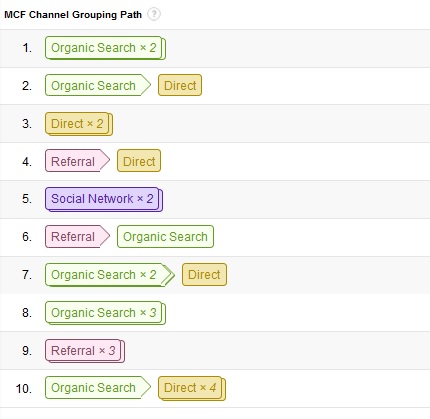Your cart is currently empty!

What Are Your Top Conversion Paths?
What are the main paths your visitors use to reach the point of conversion at your website? If you have Goals set up, Google Analytics will tell you. Just go to Conversions> Multi-channel Funnels> Top Conversion Paths, and you can find out.
The image here is from our lab site, FreshPlans, and we can see that organic search is the most important element of our customer journey. Most conversions take place once a visitor has arrived by search a couple of times, or has found us through search and then come back with a bookmark or by typing in the web address. Some find us through social networks or referrals (links on other sites) and come back again by the same or by another means.
People who complete a goal at FreshPlans have typically visited twice or more, sometimes returning a number of times before they complete that goal. That’s what we see at most websites. In fact, for websites where a conversion has a higher price point, we can see that some visitors have come to the site dozens of times before they complete a goal.
So repeat visits are common. There are other generalizations we could make — search, and especially Google search, is almost everyone’s top source of conversions — but even the simplest path to conversion report is not as simple as it looks at first. Here’s why: the long tail.
That large blue piece of pie is two visits through Google organic search. For our clients, that is normally the #1 source of conversions. The green sliver is, for this client, ads. The orange bit is three Google search visits.
When a website comes up repeatedly while a prospective client is searching for information, conversion becomes more and more likely.
That yellow sliver is another type of ad, and the aqua shows people who found the site with Google search and then came back directly, perhaps through a bookmark. There’s a little more visiting from ads and search, and by the time we include people who visited four times via search before converting, we’ve got a little more than one quarter of all the conversions covered.
One fourth of the conversions. Nowhere near most.
Look through all the conversions at a website and you’ll see a wide range of patterns, from those who came through Twitter a couple of times and then came directly and completed their transaction, to those who visit the website regularly to read the blog, and convert after a few months of doing so. The most common paths to conversion may be the ones you focus on, but it’s important not to ignore the rest — because they are the majority.
Unfortunately, it can be hard to see any patterns when you’re looking at big data like this. Combinatorics tells us that the visitors who make several visits from the main traffic sources (search, both paid and organic, referral including social, and direct) can make those visits in thousands of different combinations and permutations.
One way to get a better sense of the paths to conversion is to reduce the number you’re looking at. When we limit the report to a length of time that gives us a smaller number of conversions, we reduce the overall accuracy, but we may also make the data more manageable. In the pie graph below, we can see that, for this site, organic search and direct traffic command the largest percentages of the paths to conversion — but we can also see that referrals and social networks show up enough to be worth the investment.
We can also define groupings. For example, we saw that Google counted traffic from Twitterfeed as referral, while from the point of view of our marketing strategy it belongs to the Social grouping. There were other items which were defined as Social, such as Blogger and Reddit, which really aren’t part of our social media strategy. When we defined Social to include just the sources we include in our social media strategy, we got a clearer picture of how Social Media is performing, compared with Linkbuilding.
Again, it’s clear that direct visits and organic search are the workhorses here, but at least on this day, social media played some part in half the top ten paths.
Just a little time exploring this report will give you a clearer idea of the paths to conversion your visitors follow — chances are, they’re longer and windier than you think.
by
Tags:




Leave a Reply